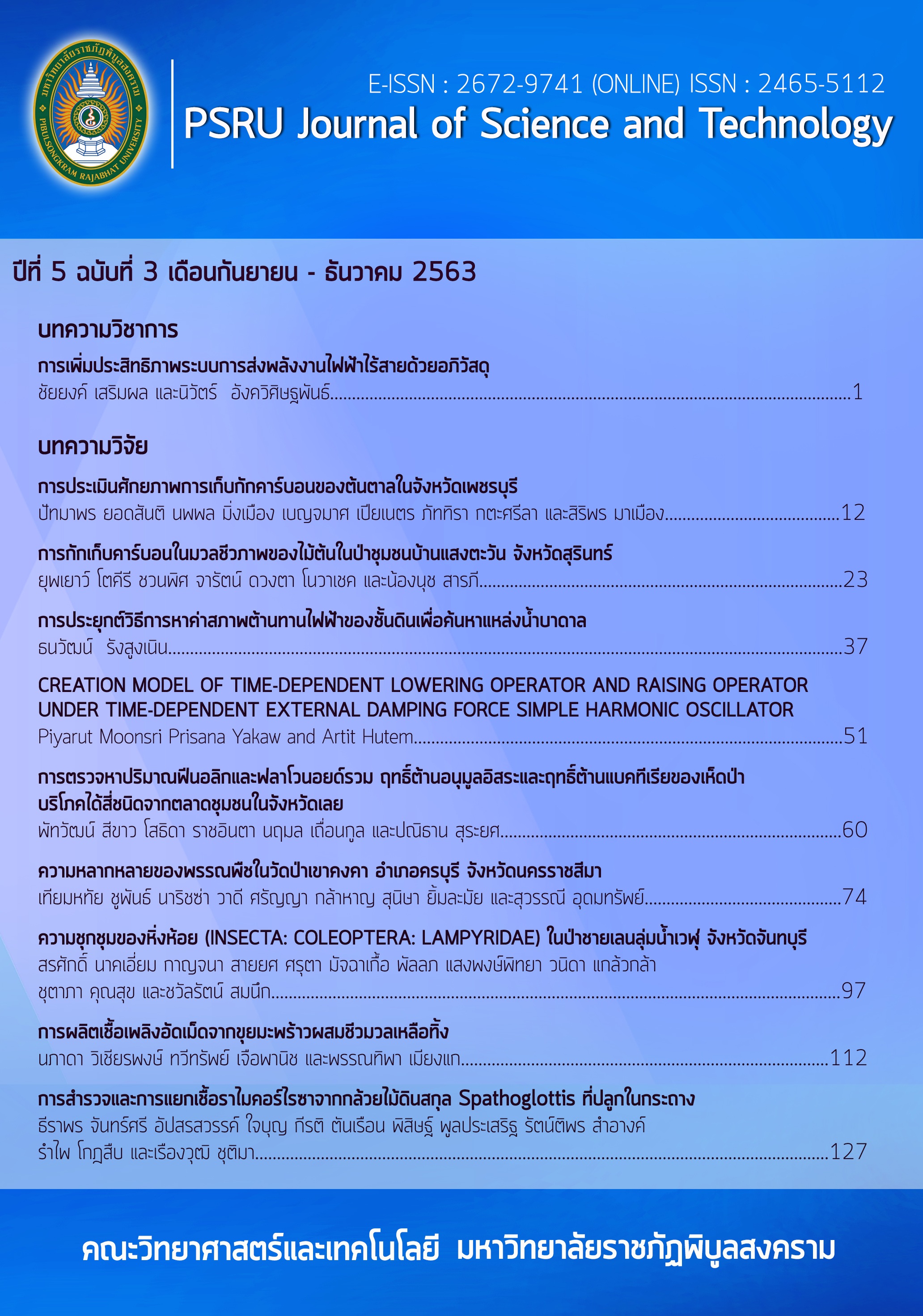INVESTIGATION AND ISOLATION OF MYCORRHIZAL FUNGI FROM TERRESTRIAL ORCHID GENUS SPATHOGLOTTIS GROWN IN POT
Keywords:
Terrestrial orchid, Peloton, MycorrhizaAbstract
This research aims to investigate the mycorrhizal relationship and isolate mycorrhizal fungi from terrestrial orchid, genus Spatthoglottis, which grown in pot to use as basically data for development of fungal inoculum and enhancing growth of terrestrial orchid grown in pot. The roots of 3 Spathoglottis orchids were corrected, randomly and stained with 0.05% w/v trypan blue. The results showed that the peloton structures, coil of fungal hypha, were found in cortex root tissues of all 3 orchid plants. In addition, 6 fungal isolates were isolated from roots of these 3 orchid samples and all fungal isolates were able to culture in laboratory without host plant. The fungal morphological study, including of fungal colony on agar media and characterization of hyphaunder microscope, revealed that all fungal isolated belonged to higher fungi due to septate hypha were found. Moreover, 5 fungal isolates were found spore formation after cultured on Potato dextrose agar (PDA) while fungal isolate SPGT 006 was not found spore formation. This research indicated that the mycorrhizal relationship was found in terrestrial orchid, genus Spathoglottis, grown in pot and all isolated fungi were able to culture in laboratory without their host plants. Therefore, these results are possibility for further study to develop mycorrhizal inoculum for terrestrial orchid grown in pot.
References
เกศสุคนธ์ มณีวรรณ. (2560). ผลของราอาร์บัสคูลาร์ไมคอร์ไรซาที่แยกจากดินเค็มต่อการเจริญเติบโตของพืช. แก่นเกษตร, 45, 985-990.
ครรชิต ธรรมศิริ. (2550). เทคโนโลยีการผลิตกล้วยไม้. กรุงเทพฯ: อัมรินทร์พริ้นดิ้งแอนด์พับลิซซิ่ง.
ชลาลักษณ์ ราชนารินทร์. (2561). ราเอนโดไฟท์ที่แยกได้รากกล้วยไม้ดินบางชนิดในประเทศไทยและศักยภาพในการส่งเสริมการงอกของเมล็ดกล้วยไม้. (วิทยานิพนธ์ปริญญามหาบัณฑิต). มหาวิทยาลัยเชียงใหม่, สาขาจุลชีววิทยาประยุกต์.
ทัศนัย ปัญจันทร์สิงห์. (2560). ความหลากหลายของกล้วยไม้ในศูนย์การศึกษาสามพร้าวมหาวิทยาลัยราชภัฏอุดรธานี. อุดรธานี: มหาวิทยาลัยราชภัฏอุดรธานี.
นฤมล เถื่อนกูล. (2562). การใช้ผลของพืชบางชนิดทดแทนมันฝรั่งในสูตรอาหารเลี้ยงเชื้อพีดีเอ. PSRU Journal of Science and Technology, 4(3), 27-36.
ปวริศ ใจคำ, อรวรรณ ฉัตรสีรุ้ง, และณัฐา โพธาภรณ์. (2557). ผลของไมคอร์ไรซากล้วยไม้และหินฟอสเฟตต่อ การเจริญเติบโตของกล้วยไม้สกุลฮาเบนาเรีย. แก่นเกษตร, 42(3), 484-489.
เพ็ญลักษณ์ ชูดี, สปัน ไม้ดัดจันทร์, อำนวน อรรถลังรอง, และสมพร เหรียญรุ่งเรื่อง. (2558). ทดสอบพันธุ์กล้วยไม้สกุลสแปโทกลอททิส (รายงานผลการวิจัยประจำปี). เชียงราย: ศูนย์วิจัยพืชสวนเชียงราย สถาบันวิจัยพืชสวน กรมวิชาการเกษตร.
เรืองวุฒิ ชุติมา, หทัยชนก ทุเรียน, และอรพินธ์ รุ่งเรือง. (2561). สภาวะที่เหมาะสมต่อการเจริญของเชื้อราไมคอร์ไรซากล้วยไม้เพื่อผลิตหัวเชื้อไมคอร์ไรซาอย่างง่าย. Rajabhat Journal of Sciences, Humanities and Social Sciences, 19(1), 167-175.
อบฉัตร ไทยทอง. (2549). กล้วยไม้เมืองไทย. กรุงเทพฯ: สำนักพิมพ์ บ้านและสวน.
อาภรณ์ อุดมศิลปะ. (2556). พืชอนุรักษ์ในบัญชีไซเตสกล้วยไม้ป่าในผืนป่าตะวันออก. กรุงเทพฯ: ชุมนุม สหกรณ์การเกษตรแห่งประเทศไทย.
Aewsakul, N., Maneesorn, D., Serivichyaswat, P., Taluengjit, A. & Nontachaiyapoom, S. (2013). Ex vitro symbiotic seed germination of Spathoglottis plicata Blume on common orchid cultivation substrates. Scientia Horticulturae, 160, 238–242.
Athipunyakom, P., Manoch, L. & Piluek, C. (2004). Isolation and identification of mycorrhizal fungi from eleven terrestrial orchids. Kasetsart Journal (Natural Science), 38, 216-228.
Attipunyakom, P., Manoch, L., Piluek, C., Artjaripong, S. & Tragulrung, S. (2004). Mycorrhizal fungi from Spathoglottis plicata and the use of these fungi to germinate seeds of S. plicata in vitro. Kasetsart Journal (Natural Science), 37, 83-93.
Brundrett, M., Bougher, N., Dell, B., Grove, T. & Malajczuk, N., (1996). Working with mycorrhizas in forestry and agriculture. Canberra: Pirie Printers.
Chutima, R., Dell, B., Vessabutr, S., & Lumyong, S. (2011). Endophytic fungi from Pecteilis susannae (L.) Rafin (Orchidaceae) a threatened terrestrial orchid in Thailand. Mycorrhiza, 21(3), 221-229.
Chutima, R. & Lumyong, S. (2012). Production of indole-3-acetic acid by Thai native orchid-associated fungi. Symbiosis, 56(1), 35-44.
Guimareães, F.A.R., Pereira, M.C., Felicio, C.D.S., Torres, F.D.P., Oliverira, S.F. & Veloso, T.G.R. (2013). Symbiotic propagation of seedings of Cyrtopodium glutiniferum Raddi (Orchidaceae). Acta Botanica Brasilica, 27(3), 590-596.
Khamchatra, N., Dixon, K., Chayamarit, K., Apisitwanich, S. & Tantiwiwat, S. (2016). Using in situ seed baiting technique to isolate and identify endophytic and mycorrhizal fungi from seed of a threatened epiphytic orchid, Dendrobium friedericksianum Rchb.f. (Orchidaceae). Agriculture and Natural Resources, 50, 8-13.
Kodsueb, R. & Lumyong, S. (2017). The first report of Aschersonia placenta Berk. on mulberry field in Thailand and effect of plant extracts to the growth of the fungus. Rajabhat Journal of Sciences, Humanities and Social Sciences, 18, 187-200.
McKendrick, S.L., Leake, J.R., Taylor, D.L. & Read, D.J. (2002). Symbiotic germination and development of the mycoheterotrophic orchid Neottianidus-avis in nature and its requirement for locally distributed Secacina spp. New Phytologist, 154, 233-247.
Otero, J.T., Flanagan, N.S.,Herre, E.A., Ackerman, J.D. & Bayman, P. (2007). Widespread mycorrhizal specificity correlates to mycorrhizal function in the neotropical, epiphytic orchid Ionopsis utricularioides (Orchidaceae). American Journal of Botany, 94(12), 944-1950.
Sangthong, S. (2002). Effect of Endomycorrhizal Fungus on Growth of Dendrobium scabrilingue Lindl. and its Hybrids. (Master’s thesis). Chiang Mai University.
Sathiyadash. K., Muthukumar T., Uma E. &Pandey, R.R. (2012). Mycorrhizal association and morphology in orchids. Journal of Plant Interactions, 7(3), 238-247.
Smith, S.E. & Read, D.J. (2008). Mycorrhizal Symbiosis. (3nd ed.). San Diego: Academic Press.
Suarez P.l. & Kottke I. (2016). Main fungal fungalpartneres and different levels of specificity of orchid mycorrhizae in the tropical mountain forests of Ecuador. Lankesteriana, 16(2), 299-305.
Swarts N.D. & Dixon K.W. (2009). Terrestrial orchid conservation in the age of extinction. Annals of Botany, 104, 543-556.
Trappe J.M. (2004). A.B. Frank and mycorrhizae: the challenge to evolutionary and ecologic theory.Mycorrhiza, 15, 543-281.
Wu, P.H., Huang, D.D. & Chang, D.C.N. (2011). Mycorrhizal symbiosis enhances Phalaenopsis orchid’s growth and resistance to Erwinia chrysanthemi. African Journal of Biotechnology, 10(15), 10095-10100.
Wrigth, M., Cross, R., Dixon, K., Huynh, T., Lawrie, A., Nesbitt, L., Prichard, A., Swarts, N., & Thomson, R. (2009). Propagation and reintroduction of Caladenia. Australian Journal of Botany, 57, 373-387.
Downloads
Published
How to Cite
Issue
Section
License
กองบรรณาธิการขอสงวนสิทธิ์ในการปรับปรุงแก้ไขตัวอักษรและคำสะกดต่างๆ ที่ไม่ถูกต้อง และต้นฉบับที่ได้รับการตีพิมพ์ในวารสาร PSRU Journal of Science and Technology ถือเป็นกรรมสิทธิ์ของคณะวิทยาศาสตร์และเทคโนโลยี มหาวิทยาลัยราชภัฏพิบูลสงคราม และ
ผลการพิจารณาคัดเลือกบทความตีพิมพ์ในวารสารให้ถือมติของกองบรรณาธิการเป็นที่สิ้นสุด







